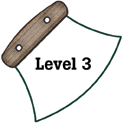|
National Science Education Standards
Millions of species of animals, plants, and microorganisms are alive
today. Although different species might look dissimilar, the unity among
organisms becomes apparent from an analysis of internal structures, the
similarity of their chemical processes, and the evidence of common ancestry.
(Page 158)
|
|
Benchmarks
One of the most general distinctions among organisms is between plants,
which use sunlight to make their own food, and animals, which consume
energy-rich foods. Some kinds of organisms, many of them microscopic,
can not be neatly classified as either plants or animals. (Page 104)
Animals and plants have a great variety of body plans and internal structures
that contribute to their being able to make or find food and reproduce.
(Page 104)
Similarities among organisms are found in internal anatomical features,
which can be used to infer the degree of relatedness among organisms.
In classifying organisms, biologists consider details of internal and
external structures to be more important than behavior or general appearance.
(Page 104)
For sexually reproducing organisms, a species comprises all organisms
that can mate with one another to produce fertile offspring. (Page 104)
All organisms, including the human species, are part of and depend on
two main interconnected global food webs. One includes microscopic ocean
plants, the animals that feed on them, and finally the animals that feed
on those animals. The other web includes land plants, the animals that
feed on them, and so forth. The cycles continue indefinitely because organisms
decompose after death to return food material to the environment. (Page
104)
|

